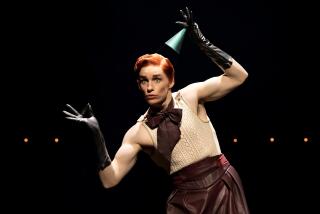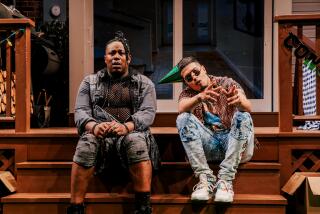Annette Bening will solo at Geffen Playhouse, but she won’t be alone

Annette Bening will tell you about Sinatra’s phrasings, the beauty and brutality of “The Iliad,” homeless enchanters, acting classes, the knife edge between the hilarious and the tragic and those transcendent roles such as her adulterous real estate agent in “American Beauty,” when “the roof comes off and there’s this whole other dimension. The larger part of life. I get it. It’s tangible. I’m in it.”
Dimensions are the tricks of craft for a woman who contains multitudes, precisely the character Bening will channel in her solo performance of “Ruth Draper’s Monologues” at the Geffen Playhouse. The show — previews begin Tuesday — is a glimpse at one of the last century’s great chameleons. A socialite who knew her way around the world’s drawing rooms, Draper created a slipstream of idiosyncratic characters, each summoned by sly shifts in voice, inflection and language.
“I have this weird interest in this lady,” said Bening, 55, eating nuts and cheese before an afternoon rehearsal. “She had an ability to listen and re-create accents, cadences, different ages of people. There were over 50 of them, and they were all in her head.... Some are extremely serious, gut-wrenching. Some are made up. There’s this whole series of Slovakian folk tunes that are nonsense.”
PHOTOS: Arts and culture in pictures by The Times
Bening laughed and sang a bit of gibberish with an Eastern European accent. She will perform four of Draper’s monologues, including “The Italian Lesson,” in which a well-tended matron repeatedly interrupts her language instruction to deal with rambunctious children, a husband, a dog, a lover, gossip and phone calls. The sketch is a study in tumult, grace and humor; moods brush against one another, spin and fall away only to be replaced by new intonations, as if sounds and conspiracies echo through prisms of light.
Born in 1884, Draper was a vagabond of standing and style, traveling and performing through two world wars and entertaining the likes of Henry James, Queen Mary and Benito Mussolini. The granddaughter of the editor of the New York Sun, she epitomized — and at times subtly skewered — upper-crust fascinations. She was popular, especially in Britain, and died in her sleep at age 72 not long after a winter show in New York. Her monologues, which included the ruminations of a Maine housewife and the schemings of an ambitious actress, inspired Lily Tomlin, John Lithgow and others. “Ruth Draper makes movies for the ears,” Tom Waits said.
Draper’s voice was sharp and textured. Bening’s is rich and expansive, intimate, husky, sexy, searching. Cunning and kindness hide there; its pitch can whirl and change in an instant, whether she’s slipping off a scarf or requesting tea. In an interview, she leaned forward, shifted back, speaking, hands moving, eyes narrowing behind rimless glasses balanced on a face with little trace of makeup. Her glamour is the ease with which she wears her age; her allure is the diverse lives she has embodied to get here, from a seducing con artist in the long-ago “The Grifters” to a widow in the recent “The Face of Love.”
PHOTOS: Celebrities by The Times
She has an innate curiosity and a perfectionist’s will. These qualities have been distilled over the years into indelible moments: the title character in “Being Julia,” sitting alone and drinking beer amid the jewels, regrets and refinements of 1930s London, and Carolyn Burnham in “American Beauty,” who after failing to sell a house dissolves into tears and rage, slapping herself, and then, as if a flower blooming backward, regains her composure, her heels echoing through an empty room and out the door.
Along the way Bening, who has been nominated for four Academy Awards, has dealt with the “inner demons” of craft and success. “You feel fear,” she said of acting. “Can you get there and can you make it real?” As it did with Draper and her menagerie, time has honed Bening’s understanding of well-drawn characters: “There are no villains, just people doing their best,” she said of Draper’s alter egos. “The frailties, the faults, the weaknesses, what is ridiculous ... that’s what I’m trying to tease out.”
Bening encountered Draper’s works in the 1980s while studying text and phrasing at the American Conservatory Theater in San Francisco. “Frank Sinatra was a great phraser because you really understood the story and you could tell in the lyric ... and she [Draper] was this great example who really knew how to phrase something.”
CHEAT SHEET: Spring arts preview 2014
Her fascination with the artist began later as she listened to recordings of the monologues while driving around Los Angeles with her four young children. “My kids fell in love with them. We all did. They still quote lines from some of the pieces,” she said, adding that Draper “observed with such acumen but at the same time great compassion” that allowed characters to emerge in layers of complexity and nuance.
This is perhaps most poignant in “Three Women and Mr. Clifford,” in which the voices of an industrialist’s wife, mistress and secretary shade in and complete the full picture of the man. In a foreword to a 1999 biography, “The World of Ruth Draper” by Dorothy Warren, actress Helen Hayes said Draper, who overcame upper-class disdain for female stage actors, “had a rich understanding of humanity and the world around her. How she could make an audience glow with recognition. . . Too bad she came before the videotape.”
Draper occasionally was heard on the radio, but there is scant film footage of her performances. She had a vivid imagination and improvised based on her audience’s reactions. “I think that what I do is something that, as a child, I never lost,” she told author and broadcaster Studs Terkel in 1955, according to the website DraperMonologues.com. “Which is the child’s capacity to throw themselves completely into what they pretend to be ... [and] if you’re completely given over to what you’re trying to portray, you will convince the other people too.”
PHOTOS: Hollywood stars on stage
She added: “I think everybody is rather ridiculous and pitiful. I try to show both sides, the humorous and the serious human qualities. My people are just made up of all parts, the way everybody is, I think.”
Her monologues conjure an array of personalities — some inspired and fictionalized from her own experiences — that would be daunting for any actress to re-create. So much so that Bening has stopped listening to Draper’s recordings. “I need to make them my own,” she said. “Five billion people have played Hamlet. ‘To be or not to be.’ And how do you do that and find your way into your own journey, your own way of telling it?”
For a number of years after “Draper’s death, performances of her work were sporadic, and included the occasional drag version,” wrote Susan Mulcahy, founder of DraperMonologues.com, who brought the recordings to CD. Many actors steered clear of attempting to stage the dramas. The website quoted Tomlin as saying, “That would be sort of sacrilegious,” and it noted that the late Julie Harris said, “No! God save us! She was so unique.”
INTERACTIVE: Hollywood’s Theatre Row
“I revere these pieces, and I want to do [them] justice,” said Bening. “I want to share them. That’s it. It’s as simple as that.... I don’t want to do anything bizarre. I don’t want to reinterpret them in some way that would be offensive to anyone.”
A graduate of San Francisco State, Bening started in theater and was nominated for a Tony Award for her 1987 portrayal of a photographer in “Coastal Disturbances.” In 1999, she was the title character in Ibsen’s “Hedda Gabler” at the Geffen Playhouse, and in 2009 starred in Euripides’ “Medea” at UCLA’s Freud Playhouse. She also became one of her generation’s most gifted film actresses; her most recent Academy Award nomination was for her 2010 portrayal as a high-strung lesbian mother in “The Kids Are All Right.”
“For a long time I thought I was just a stage actor in movies pretending to be a movie actor,” she said. “Now, I love making movies. I love being on the set.... I love the luxury of the camera. The camera does so much for you. I like the secrets a camera can tell. But the stage I also love. It’s why I’m back. There’s a kind of athleticism. There’s a sort of physical and emotional immediacy to the experience.... You slowly work your way through untangling the strands.”
PHOTOS: Best in theater for 2013 | Charles McNulty
Her upcoming films include a biography of Howard Hughes, shooting now and directed by Warren Beatty, her husband, and “The Search,” in which she plays an American aid worker during the war in Chechnya. Mention of that conflict led her into a conversation on breakaway Soviet republics, the rise of Russian President Vladimir Putin and the current tensions in Crimea. Bening said understanding life’s foibles and intricacies, its comedies and tragedies, offers an actor the chance to “find that thing” at the edge of creativity and spontaneity .
“The most important quotient is what you don’t know. What you can’t plan. What you don’t want to plan,” she said. “You know if you plan it, it’s not going to be the gold thing. The thing that’s really precious is the thing that you don’t know what it’s going to be.... The thing you want to get to is that thing you don’t control and can’t name.”
She held up her hand and rubbed a thumb across her fingers, as if bartering in a foreign land. There was no word for the “thing”; it either came or it didn’t, like a whisper on a sudden wind.
More to Read
The biggest entertainment stories
Get our big stories about Hollywood, film, television, music, arts, culture and more right in your inbox as soon as they publish.
You may occasionally receive promotional content from the Los Angeles Times.







